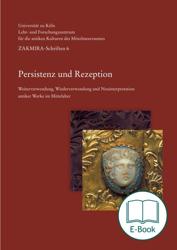The present volume is based on a colloquium held by two research centres of the Philosophical Faculty of Cologne University. i.e. the “Centre for Mediterranean Cultures (Zakmira)” and the “Centre for Medieval Studies”. The contributions by various authors from the departments of archaeology, history, Judaic studies, history of art, medieval Latin and philosophy present and compare from the interdisciplinary point of view numerous varied phenomena of continuing utilization and new interpretation of antique works in different fields.
In many spheres of the practical and intellectual life the Middle Ages build on the knowledge, structures and achievements of the antique age. They also integrate them in various ways in their own cultural order. Even in medieval towns the ancient street patterns, fortifications and prominent buildings determined the local structure, which was absorbed and adapted to new requirements. This happened by abandoning certain areas, by converting buildings or by putting up new structures on top of them. Learning, science and arts of the antique age were appreciated by royal courts and monasteries. Many works of antique literature were copied, commented on or rearranged. Antique precious objects were kept in treasuries. They were given away as gifts; and were often even fashioned into new objects. These however are only a few examples for the intense occupation with antique culture during the Middle Ages.
In recent decades archaeological research has intensively explored the late antique age. The interest concentrated on the transformation of the antique repertoire in a changed political and religious environment. It also covered continuing existence and activity of daily life structures as well as styles. In the 20th century German medievalist research in fields of history and art for a long time paid particular attention to reception of antiquity in the context of Carolingian and Ottonian Renovatio Imperii, i.e. ruler’s strategy of legitimation as well as to the renaissance of science in the 12th century. Recent publications identify the continuation and modifications of antique administration procedures, terms of guidance, legal codes and text-books. They also reflect upon medieval ideas and fictions about the antique age.
The present volume takes up these new initiatives. It is based on a colloquium held by two research centres of the Philosophical Faculty of Cologne University. i.e. the “Centre for Mediterranean Cultures (Zakmira)” and the “Centre for Medieval Studies”. The contributions by various authors from the departments of archaeology, history, Judaic studies, history of art, medieval Latin and philosophy present and compare from the interdisciplinary point of view numerous varied phenomena of continuing utilization and new interpretation of antique works in different fields.
The terms “Persistence” and “Reception” in the title of this volume refer to the various kinds of continuing existence related to the antique age during the Middle Ages. “Persistence” aims at the tenacity of antique relics and at the apparently obvious acceptance and continuation of transmitted forms, subjects and structures. “Reception” accentuates the deliberate acceptance of distinct cultural forms of the antique age by the cultural elite of medieval society. Thus the different perspectives of antiquity and of medievalist science are accommodated. Disciplines are brought together which usually are separated by subject and methods.
„13 Autoren eines Kölner Kolloquiums mit Teilnehmern aus der Archäologie und 7 mediävistischen Fächern legen eine facettenreiche Sammlung vor. Für das „Nachleben“ antiker Werke im Mittelalter (= MA), was bisher vorwiegend Thema von Kunstgeschichte und Archäologie war, wird der Blick erheblich erweitert, worüber hier nicht angemessen informiert werden kann.“
In: Museum Helveticum. (2009). S. 168.
--------------------------------------
„Insgesamt wird man die Bedeutung der hier behandelten Fragestellung nicht bestreiten können, und insofern gehört dieser Sammelband zu den besseren seiner Art, wenngleich man bedauern mag, daß die Zunft der Mittelalterhistoriker ein wenig unterrepräsentiert ist.“
In: Deutsches Archiv für Erforschung des Mittelalters. 65,1 (2009). S. 433-435.
Dietrich Boschung war nach Lizentiat (1982) und Promotion (1983) in Bern von 1983-84 Hochschulassistent in Bern, danach Hochschulassistent in München. 1989 Habilitation an der Ludwig-Maximilians-Universität München. Zusätzliche Lehrtätigkeit an den Universitäten Augsburg und Marburg. 1993 bis 1994 Leiter des Forschungsarchivs für Antike Plastik am Archäologischen Institut der Universität zu Köln, von 1995 bis 1996 Professor für Klassische Archäologie an der Universität Regensburg. Seit 1996 Professur an der Universität zu Köln
Forschungsschwerpunkte: Antike Bildsprache, Antike Herrschaftssysteme und ihre mediale Präsentation, Sepulkralkunst der frühen Kaiserzeit, Sammlungen antiker Skulpturen im 17. und 18. Jahrhundert.
Susanne Wittekind studierte Kunstgeschichte, Neuere und Mittlere Geschichte sowie Philosophie in Tübingen und München 1984-93, gefördert durch die Studienstiftung des deutschen Volkes. Promotionsstipendiatin des Graduiertenkollegs „Politische Ikonographie“ in Hamburg (1990-92), Promotion 1993 in München, Post-Doc-Stipendiatin des Graduiertenkollegs „Schriftkultur und Gesellschaft im Mittelalter“ in Münster mit einem Projekt über die Kunststiftungen Abt Wibalds von Stablo (1993-95). Arbeitsprojekt „Christliche Kunst im 19. Jahrhundert (J. Schnorr v. Carolsfeld, L. Richter, J. Führich)“ 1996/97. 1999 Habilitation in München mit einer Arbeit über „Reliquiar, Retabel - Kunst der Liturgie im Mittelalter. Benediktinische Reform in den Kunststiftungen des Abtes Wibald von Stablo“ (gedruckt bei Böhlau 2004). Seit Sommersemester 2002 Professorin für Kunstgeschichte (Schwerpunkt Mittelalterliche Bildkünste) an der Universität zu Köln.
Forschungsschwerpunkte: Mittelalterliche Buchmalerei und Schatzkunst, Text-Bild-Forschung, Kunst und Liturgie, Deutsche Malerei des 19. Jahrhunderts, Historienmalerei 19. Jahrhundert


 Preface
Preface